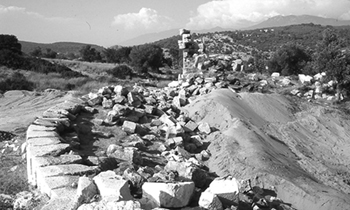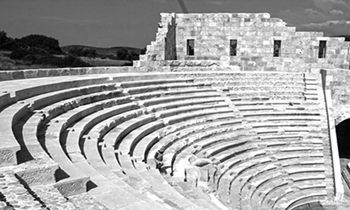Assembly Building


The Assembly Building (Bouleuterion in ancient Greek), one of the historical and architectural riches of Patara, is located behind the Western Stoa of the Agora in the center of the city, north of the Theater. The architectural design of the building is characterized by two basic geometric forms, rectangular and semicircular. Spread over an area of approximately 1300 square meters, the height of the building was measured as 17 meters thanks to the northwest corner wall preserved up to the roof level.
The orchestra floor of the Parliament building is covered with green-blue Cippolino marble of Italian origin. A semicircular cavea with 21 steps rises from the orchestra. On the central axis of the cavea there is a special semicircular box (tribunal) reserved for high level executives (speaker of the assembly, governor of the state, etc.). To the east of the orchestra is a high podium in the simple architectural style typical of Lycia; however, this section is the worst preserved part of the building. At the north and south ends of the cave there are two rooms covered with barrel vaults. It is thought that the southern room may have been used as an archive and the northern as a dungeon.
The Patara Assembly Building is a multi-phase structure and continued to exist with modifications, repairs and additions into the later periods of the Eastern Roman Empire:
- First phase: The building was constructed during the Late Hellenistic Period (late 2nd - early 1st century BC), when it was used as a meeting place for the Lycian League.
- Second phase: It covers the period when Patara retained its status as capital and Lycia was transformed into a Roman province. This phase is associated with major building activities under Emperor Claudius (43-51 AD) or Emperor Nero (51-69 AD).
- Third phase: It took place after the Lycian earthquake in 142 AD. During this period, a stage building and an external stoa were added to the building, as well as the function of the Odeion (a large hall where musical performances and competitions were held).
- Fourth phase: During the Late Roman-Early Eastern Roman period, the building was integrated into the Late Antique wall and transformed into a corner bastion. During this phase, the interior of the building was almost completely filled with excavations.
The Patara Assembly Building was home to the impressive governance model of the Lycian League. The famous philosopher Montesquieu described the Lycian League's form of government as “the most perfect example of a republic” in his work The Spirit of Laws. This magnificent structure reflects the importance of Lycian history and architecture and allows for the implementation of one of the best-known forms of government in history.
Between 2008 and 2012, extensive conservation and restoration works carried out by the Grand National Assembly of Turkey (TBMM) preserved the architectural details of the building and transferred it to the future.



<
Assembly BuIldIng
Assembly BuIldIng
Assembly BuIldIng
>
All works (text, images, visuals, photos, videos) featured on this website are related to the Patara excavations and are protected under the Law on Intellectual and Artistic Works no. 5846 and the Turkish Penal Code no. 5237. Their contents cannot be reproduced, even with citation, without permission. They cannot be copied unlawfully or published elsewhere without authorization. Those who violate these rights will be subject to the legal and penal sanctions outlined in the Law on Intellectual and Artistic Works no. 5846 and the Turkish Penal Code no. 5237.
© Copyright PataraKazıları 1988
Web Designer Mustafa AĞGÜL
